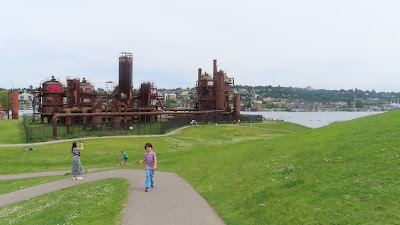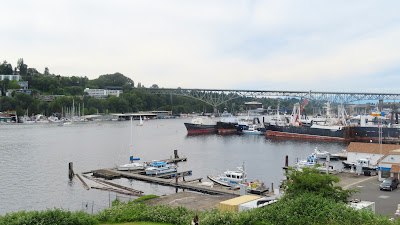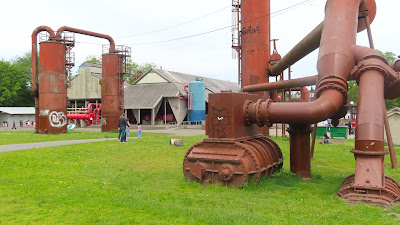The
silhouette of a crow standing on the remnants of a house in Altadena. Photo by
Myriam Mahiques, March 2025.
In architecture,
sound is studied as acoustic design and it is focused on concert halls and
theaters. But the sound of the
environment is usually not considered.
During the
wildfires and immediately after, the loudest sounds will be related to
firefighters’ effort. The desperation in human voices, the evacuation orders,
will open the path to sirens, roars of cars and then bulldozers clearing
debris.
Those are the
immediate sounds that will be replaced by a long period of silence. I have been walking amidst the ruins of
Altadena, and the lack of urban sound, except for the crows and distant
roosters, is truly impressive. My
perception of the place was affected, it reminded me somehow of my visits to
the countryside, but without the birds’ songs.
A
single bird in the distance amidst the ruins of a house in Altadena. Photo by
Myriam Mahiques, March 2025.
In California, a
group of researchers with data collected since 2009, mapped the sounds of the
Hermit Warbler and analyzed the impacts caused by forest fires on the birds’
songs. They found that after the massive effect of bird dispersion, other
individuals from different groups come to inhabit the affected areas, provoking
a diversity of sounds which they call “introduction of new dialects”, in other
words a Babel of bird songs.
Environmental sound
can generate spatial engagement and provoke different reactions in humans
depending on the context. The place can be “felt” in communion and this feeling
will trigger memories:
“Sound as a concept invites us into the materiality of
things, not to deny the visual but to augment how we might see; and it
transgresses the boundaries between the object, the thing looked at, and the
space and context of its appreciation, introducing a sense of simultaneity
instead of pre-existence…” (Salome Voegelin. The
Political Possibility of Sound. 2019).
To understand what
is ending, he proposes to look at the past. He cites one of the first America’s
professional naturalists, William Bartram, whose travel report in America recounts the beauty
of different plants and animals species in a wild fresh land.
But before Bartram,
and coming back to the soundscape, it is interesting to recall the work of the
German Jesuit monk Athanasius Kircher (1602-1680), author of the first
acoustics treatise in the West, Phonurgia Nova (1673), published in the second
half of the 17th century. Kircher designed a sounding city through acoustic
experiments, for example, taking distances to represent the echoes based on a
site’s topography. The echo was of common knowledge due to Ovid’s myth of the
nymph Echo.
Phonurgia Nova
tried to represent the sound ambiance of a place in times where sound and
acoustics were specifically applied to the creation of instruments; the book
was related to the world of the living, to the sounds of the universe, of
nature (wind, echo, water) where humans walk alongside the divine celebrating
the wonders of our planet. It did not align with science but to religious
cosmogony. That was an anthropological point of view opposed to the Greeks’ who
conceived nature as an immutable order that humans could not infringe.
Kircher wrote about different subjects, like astronomy, optics, geology, music, magnetism, alchemy, acoustics, etc. Though his writings were not accurate on explanations of physical phenomena, he was a precursor of multidisciplinarity.
|
|
|
Experiments with echoes. From Phonurgia Nova.
|
|
|
Man, music and landscape. From Phonurgia Nova.
Nowadays, far
beyond our own perception of soundscape after a wildfire, we can rely on
scientific works that have measured it. In “Changes on soundscapes reveal
impacts of wildfires in the fauna of a Brazilian savanna” researchers M.H.L.
Duarte et al explained how they used an ecoacoustics approach to assess fauna
responses and recovery after wildfire in a Brazilian savanna. Six passive acoustic monitoring devices were
used to record soundscapes before and after a wildfire at burned and unburned
sites 24 hours a day, from September 2012 to September 2013.
They concluded that wildfire altered biophonic activity and soniferous species richness, being insects the most affected animal group; biophonic activity and soniferous species richness tended to recover one year after the fire.
Comparative pictures. From “Changes on soundscapes reveal impacts of wildfires in the fauna of a Brazilian savanna”.
“The lack of studies on fire effects on fauna is probably
a consequence of the difficulty to conduct large-scale controlled experiments
to reproduce fire impacts due to the obvious risks of fire spreading outside
the experimental areas and the ethical concerns for this elective disturbance
in such a fragile system (...) As an innovative and alternative approach,
ecoacoustics has recently proven to be effective to access and interpret
changes in animal communities in face of anthropogenic disturbances” (M.H.L. Duarte et al, 2021).
Krause is the
author of The Great Animal Orchestra among other books. His “niche hypothesis”
called attention to the role that nature sounds has in healthy ecosystems.
The effect of
global warming is expressed in the natural soundscape. Krause came back to the
places he had been recording sounds before and he showed the comparative
recordings; the silence is evident in recent years. He compares this outcome
with our voices: when we are sick, they are absolutely changed. The birds are
still there, but they are not singing.
Soundscape ecologists Bernie Krause on St Vincent Beach. Photograph by Tim Chapman. Shared from the Guardian’s article “The sound ecologist capturing a disappearing world: ‘70% of habitats I recorded are gone”.
I highly recommend
a New Yorker’s video on YouTube “How
Soundscapes Change After A Fire. The Last of the Nightingales” which
is not only beautiful in its black and white aesthetics, but also gives us the
opportunity to listen to Bernie Krause and some of his recordings.
“-So if you wanna know how to learn to feel good and
relaxed and being part of the living world around you, get involved in
listening to it because it’s fabulous.” Bernie Krause,
2025.
Sugarloaf Ridge State Park, eco-acoustic April 4th, 2008.The same calibrations are used in both days. See the differences in sounds. This one is more silent.
Birds can instinctively fly away from a wildfire, “direct mortality is not a big concern,” says U.S. Forest Service research biologist Vicki Saab, quoted on Wild Birds Unlimited, but how do they survive in devastated areas after months?. Their food will be gone, the streams will be dry and full of ashes. We could approach and interact with nature in certain ways, for example providing safe feeding stations in backyards (out of reach of dogs, cats), shadow areas and water.
Communities can be
engaged in the research about how wildfires smoke along the U.S. West
Coast impacts birds by participating in
the Project Phoenix, an initiative created by UCLA and the Natural History
Museum of Los Angeles County. The goal is developing strategies to help birds
cope with wildfires, air pollution and climate change.
https://www.project-phoenix-investigating-bird-responses-to-smoke.org/
Picture from Project Phoenix.
Music from the environment is a complex phenomenon and we should give it a thought during the design process. The interaction between humans and animals is relevant due to the positive emotional and healing effects after trauma; this is one of the aspects of Biophilic design.
Project management
teams should include the collaboration of architects, musicians, acousticians,
landscape designers, biologists.
In the words of Juhani Pallasmaa, sound provides a temporal continuum and architecture is the art of petrified silence. “Site isolates, whereas sound incorporates; vision is directional, whereas sound is omni-directional. The sense of sight implies exteriority, but sound creates an experience of interiority. (Pallasmaa, 2005)
References:
. Kircher,
Athanasius. Phonurgia Nova (1673).
. McKibben, Bill.
The End of Nature. New York. 2003.
. M.H.L. Duarte et
al. Changes on soundscapes reveal impacts of wildfires in the fauna of a
Brazilian savanna. In Science of Total
Environment. Volume 769, 15 May 2021
. Regnault, Cecile. The Instrumentarium of Kircher. Premises of a Universal Phonurgy. In The Sound of Architecture. Acoustic Atmospheres in Place. Leuven University Press. P. 179-191. 2022 EPDF edition 2025.
. The New Yorker.
“How Soundscapes Change After a Fire. The Last of the Nightingales”
https://www.youtube.com/watch?v=w-0IzU1EDdk
NOTE: this article is also published on AIA Los Angeles blog. This post has been completed with Cecile Renault's reference, which is missing from the AIA post.























































